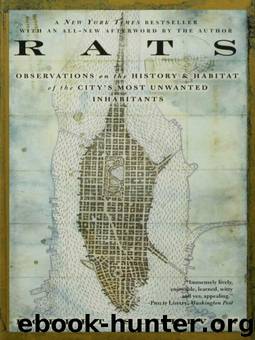Rats: A Year With New York's Most Unwanted Inhabitants by Robert Sullivan

Author:Robert Sullivan
Language: eng
Format: mobi, epub
Tags: Life Sciences, Rats, Science, Urban Pests, Mammals, Zoology
ISBN: 9781862077614
Publisher: Granta
Published: 2005-01-13T21:11:09+00:00
Chapter 14
PLAGUE
ONE REASON THAT rats have a bad reputation is that they have been at the scene of some of humanity's greatest calamities, chiefly as carriers of the plague. Plague is often referred to as bubonic plague because of its symptoms, which include a fever and swelling of the infected person's lymph nodes, or buboes, followed by convulsions, vomiting, giddiness, severe pain, and dark spots on the skin. Death results from heart failure, internal hemorrhaging, or exhaustion. Other versions of plague are pneumonic plague, which is a kind of pneumonia, and septicemic plague, which is plague that invades the bloodstream so quickly that death can occur within twenty-four hours. The plague is also known as the Black Death, though it was not called the Black Death during the Middle Ages when it wiped out as much as 80 percent of the population of most towns and villages. It was first called the Black Death by Scandinavian chroniclers writing in the sixteenth century. Though the plague can cause parts of the body to turn black, when the Scandinavian writers used the term black, they used it to mean terrible or dreadful or horrible.
Plague can live indefinitely in communities of small rodents, such as marmots and gophers and various kinds of rats; rodents are considered the natural reservoir of plague. In fact, plague infects rats and kills them too, so that it could be argued that rats are as much victims of the plague as humans. When rats get the plague, they get it from fleas—most likely, a rat fleasuch as a Xenopsylla cheopis, A rat fleais about the size of this letter o and is shaped like a miniature elephant. A flea injects its trunk like proboscis into the rat to suck blood. When a rat flea sucks in rat blood infected with plague bacteria, the plague bacteria multiplies and eventually clogs the guts of the flea; the flea starves to death. In the meantime, before the flea dies, it feeds again and regurgitates the plague bacilli into the next rat as it feeds on the rat's blood. As many as one hundred thousand bacilli can be injected into a rat by a flea, but one plague bacillus could kill an animal as large as a monkey. When the rat dies, the flea senses the temperature change of its host and leaves the body of the cold, dead rat to find a warm, live rat. The flea then infects that rat, which either stays alive and breeds the plague for a time, or dies, causing more fleas to move on to more rats. Rat fleas prefer to feed on rats, and in areas where plague-infected rodents do not regularly come in contact with humans, there may be no human plague epidemics; the disease can live without consequence to man. But because rats live so closely to man, rat fleas will feed on humans (or any warm-blooded mammal) as a kind of second choice. The rat flea can wait a while for a human to appear; it can live for six months without a meal of blood.
Download
Rats: A Year With New York's Most Unwanted Inhabitants by Robert Sullivan.epub
This site does not store any files on its server. We only index and link to content provided by other sites. Please contact the content providers to delete copyright contents if any and email us, we'll remove relevant links or contents immediately.
| Automotive | Engineering |
| Transportation |
Whiskies Galore by Ian Buxton(41720)
Introduction to Aircraft Design (Cambridge Aerospace Series) by John P. Fielding(33017)
Small Unmanned Fixed-wing Aircraft Design by Andrew J. Keane Andras Sobester James P. Scanlan & András Sóbester & James P. Scanlan(32685)
Craft Beer for the Homebrewer by Michael Agnew(18082)
Turbulence by E. J. Noyes(7895)
The Complete Stick Figure Physics Tutorials by Allen Sarah(7265)
Kaplan MCAT General Chemistry Review by Kaplan(6823)
The Thirst by Nesbo Jo(6759)
Bad Blood by John Carreyrou(6477)
Modelling of Convective Heat and Mass Transfer in Rotating Flows by Igor V. Shevchuk(6354)
Learning SQL by Alan Beaulieu(6159)
Weapons of Math Destruction by Cathy O'Neil(6085)
Man-made Catastrophes and Risk Information Concealment by Dmitry Chernov & Didier Sornette(5878)
Digital Minimalism by Cal Newport;(5588)
Life 3.0: Being Human in the Age of Artificial Intelligence by Tegmark Max(5405)
iGen by Jean M. Twenge(5326)
Secrets of Antigravity Propulsion: Tesla, UFOs, and Classified Aerospace Technology by Ph.D. Paul A. Laviolette(5237)
Design of Trajectory Optimization Approach for Space Maneuver Vehicle Skip Entry Problems by Runqi Chai & Al Savvaris & Antonios Tsourdos & Senchun Chai(4957)
Electronic Devices & Circuits by Jacob Millman & Christos C. Halkias(4866)
